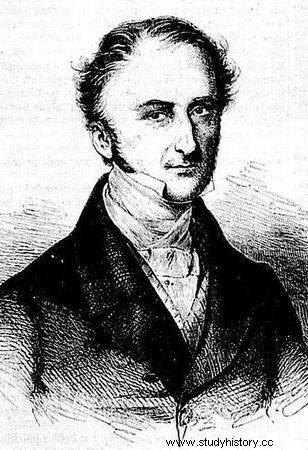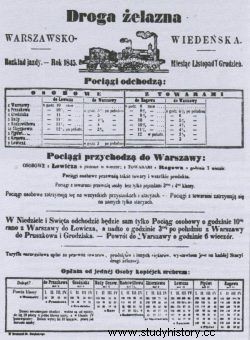We all know very well how efficiently the construction of highways in contemporary Poland is going. But how about the fact that basically nothing has changed in ... two hundred years? Work on the first railway in the Russian partition (and the railroads are, in a sense, the nineteenth-century equivalent of highways) encountered absurdities and difficulties that are well known today.
Poles, like Poles, came up with the idea very quickly. As soon as the first railway lines started operating in England, our domestic risk takers had a sense of the golden deal. In 1834 In the year, just nine years after the first locomotive traveled the pioneering section from Stockon to Darlington, two Polish financiers - Piotr Steinkeller and vice-president of Bank Polski Henryk Łubieński - commissioned preliminary study works over the railway line from Warsaw to Zagłębie Dąbrowskie and further to Vienna. After a year, the more promising one by engineer Stanisław Wysocki was selected from two possible designs. And only then did the stairs begin.
Everything in the hands of the Tsar
Poles could plan what they liked, but we are talking about the period of partitions, and that immediately after the lost November Uprising. The decision on the possible construction of the railway lay solely in the hands of the tsar, Nicholas I. There was no indication that the ruler would consent:at that time there were no railway lines in the Russian Empire yet, the tsar still had a grudge against the Poles for their independence struggle. , and the thread from Warsaw to Zagłębie would lead in the wrong direction. To civilized Europe, not to the Russian wilderness!

Piotr Steinkeller one of the originators of the first Polish railway line.
Indeed, the self-lord advisers spoke with almost one voice against the railroads in the Kingdom of Poland. The Russian Minister of Finance, Yegor Kankrin, said openly that the railway was an unnecessary whim that would only induce people to move unnecessarily from place to place (quoted after:Andrzej Żor, Kronenberg. History of Fortuna…, p. 173).
The pessimists did not foresee just one factor:Nicholas I himself was a great enthusiast of the new invention. Torn between his own dreams about the railway and the opinions of advisers, he asked ... the prince of Warsaw, governor of the Kingdom of Poland, Ivan Paskiewicz, to make a decision. The latter, after a short deliberation, signed an appropriate decree. As a result - ironically - Poles were to owe the civilization leap associated with the new means of transport to a man who brutally suppressed the November Uprising, he suppressed Polishness and Russified the nation.
The investor is responsible for the rest…
At this stage, the matter returned to the originators. The state, as is the case today in the case of motorways built under the public-private partnership system, first of all secured its consent to the investment.

Ironically, Iwan Paskiewicz decided that the Kingdom of Poland would receive the possibility of a civilization leap related to the construction of the railway. The man who brutally suppressed the November Uprising and suppressed Polishness.
The costs were initially estimated at PLN 21 million at that time. In order to cover them, 5,000 shares were issued and it was intended to be sold to potential investors. Ultimately, the shares were to be bought by the Bank of Poland (adding a dividend) and thus the railway would become the property of the state.
However, Piotr Steinkeller and Henryk Łubieński miscalculated as to the popularity of their idea. Initially, it was not possible to establish the Warsaw-Vienna Iron Road Society because there was a shortage of people willing to take action.
In the end, a few machinations were made, for example, by handing over 1,500 shares to the British company "Pontwyn and Golynor", which was to pay for them ... in a barter. It undertook to deliver 14,000 rails.
Finally in 1839 On the year of the year, the Society started its activity and the actual works started. As Andrzej Żor, author of the book "Kronenberg. Dzieje fortuny ”, in 1840 the focus was on earthworks, forest clearing, and preparation of embankments. (…) However, there was a shortage of money (p. 178).
Or maybe the carriages will be pulled by ... a horse?
In view of the financial problems and the overall unfavorable investment climate, Piotr Steinkeller and Henryk Łubieński threw up the idea of a radical cost reduction. Do you remember Edward Gierek, who for the same reasons decided to build a motorway ... with intersections (known as "Gierkówka")? The 19th century capitalists have definitely surpassed him in momentum.

And this is what one of the first timetables of the first Polish railway looked like! (1845)
They proposed that the trains should not be pulled by any locomotives, but by honest junks. Henryk Łubieński argued: In our country, oats and hay are so cheap, such cheap horses (...) that it will be possible to transport unequally cheaper [goods] with horses, as with steam engines. But (...) one should consider how to arrange the transport, whether leg by leg or trot. That the horse is pulling more slowly while walking is no question (p. 176).
Fortunately, the bizarre horse railway, which is by no means a railway, did not come into existence in the end. A special commission appointed by the state authorities forced the implementation of the "steam" variant. This already foreshadowed a catastrophe, because the originators of the entire investment completely underestimated its costs. Now they have increased from PLN 21 to 30 million.
The investor abandons the construction site ...
We know the next stage very well from our today's backyard. At some point something went completely wrong. First, one of the railroad investors, the Viennese bank Steiner et Companie, went bankrupt. Secondly, a certain Maurycy Koniar, an industrialist with excellent contacts with the Russian ruling elite, persuaded Ivan Paskiewicz to cancel the contract with the English for the supply of rails. Now, by the decision of the authorities, the rails were to be manufactured at an inflated price by the Koniar's plant. Added to this was the reluctance of the Kingdom government to issue a new share issue.

Such locomotives were drawn to the trains of the Warsaw-Vienna railway when its construction was finally completed ...
In the end, construction was suspended and the Warsaw-Vienna Iron Road Society closed the business. Anyway, from the very beginning it operated like a bush-company:it hardly ever called a shareholders' meeting and did not even have a real seat.
The state takes over the investment
The work was too advanced to abandon the project altogether. The state took it over reluctantly. The inventory took another two years and work was not resumed until 1844. In the meantime, the estimated costs increased to PLN 46 million. In real terms, they could even exceed 50 million.
Finally, at the beginning of 1845 The first 29-kilometer section from Warsaw to Grodzisk was put into operation. The entire investment was completed in April 1848 year - then the 328 km long railway line reached the border of the Russian partition.
Of course, the state-managed railway turned out to be completely unprofitable, which inhibited the development of infrastructure for the next several years. However, this is not the most interesting thing. Personally, I am consterned primarily by the fact that despite the tsarist oppression, machinations, corruption and the lack of investors, the Warsaw-Vienna railway was built much faster than most highways in the Third Polish Republic ...
Sources:
Basic:
- Andrzej Żor, Kronenberg. History of Fortune , Polish Scientific Publishers PWN, 2011.
Complementary:
- W. Sterner, The birth of the railroad , Book and Knowledge, 1964.
